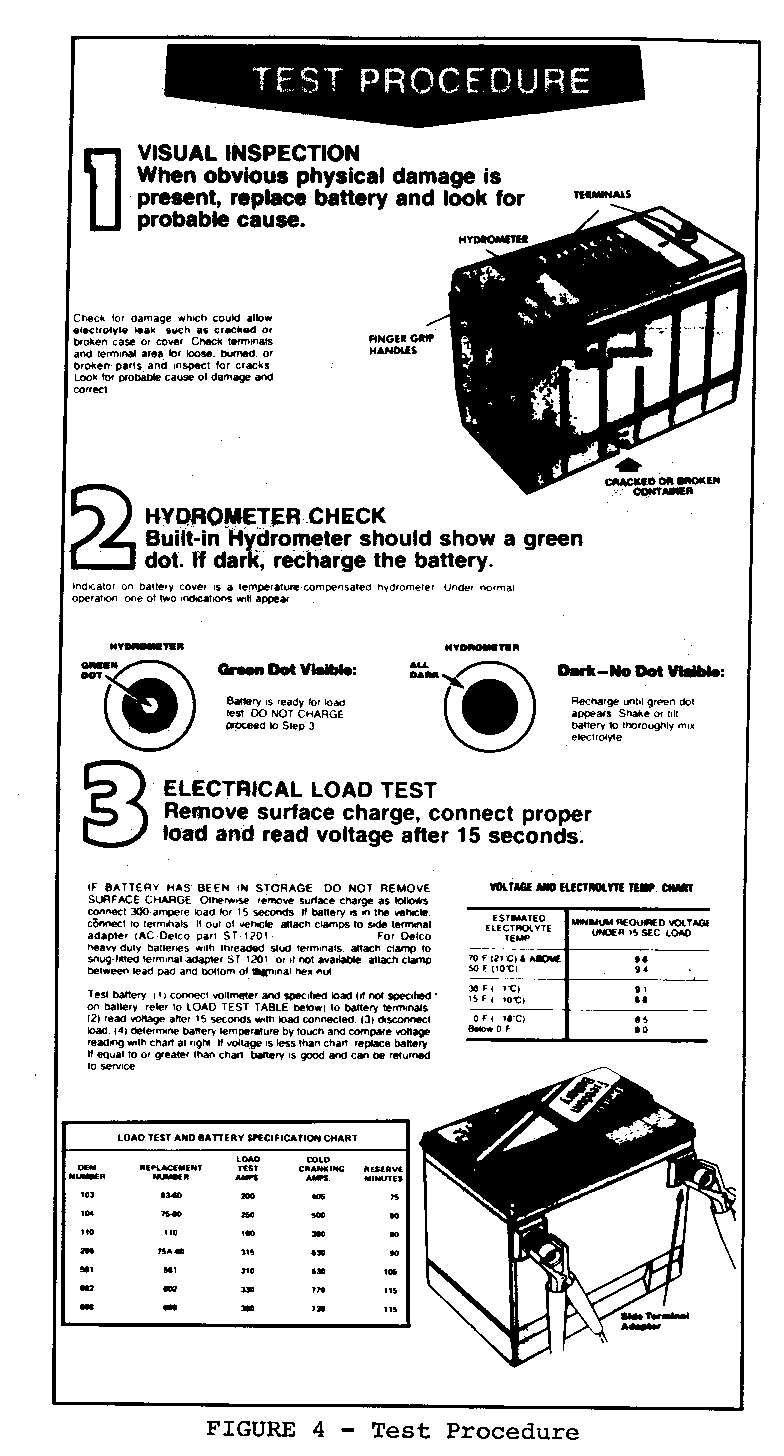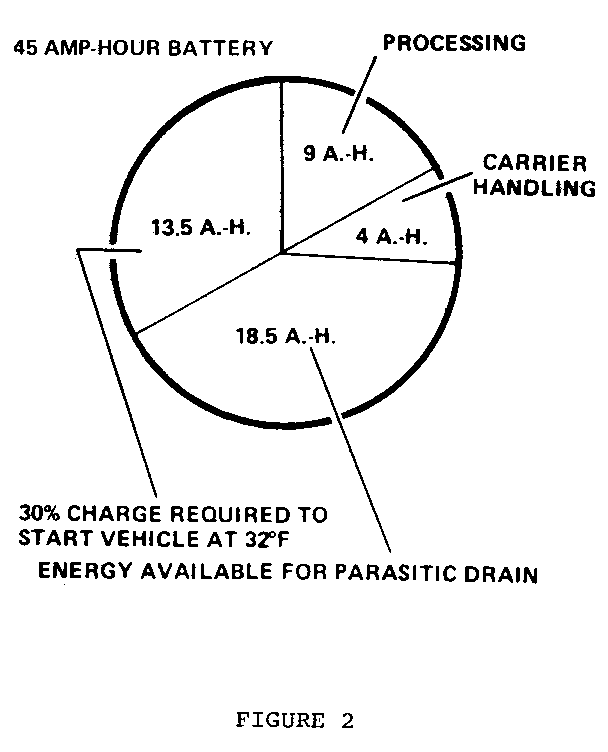DELCO FREEDOM BATTERY DIAGNOSIS-CHARGING INFORMATION

MODEL AND YEAR: ALL MODELS WITH DELCO FREEDOM BATTERIES
The following information will explain the characteristics of the Delco Freedom battery and the effects of parasitic loads (small constant drains on the battery due to standard and optional equipment). The effect of outside temperatures on battery power and proper battery charging and testing procedures are also discussed.
Notice: All batteries generate hydrogen gas which is extremely flammable. If ignited by a spark or flame, the gas may explode violently, causing spraying of acid, fragmentation of the battery and possible severe personal injuries. Wear approved eye protection. Battery fluid is corrosive acid, flush any contacted area with water immediately and thoroughly.
Most deeply discharged batteries CAN be recharged if proper procedures are followed.
Examples of conditions causing low charged or discharged batteries are:
1. Extended storage of vehicles. 2. Batteries being less than adequately charged when received. 3. Extended cranking periods due to plug fouling. 4. Driver habits. 5. Incorrect interpretation of the charge indicator. 6. Inability to determine the correct ampere-hour charging rate for a discharged battery. 7. Burned out charge/gen light bulb causing "No Charge" condition. 8. Charging system problems. 9. Continuous current draw on the battery thru increased parasitic drain.
PARASITIC LOADS
Vehicles may have several electrical devices which result in continuous current drains on their batteries. Batteries on vehicles not being used for an extended period may become discharged by these small current drains called parasitic loads.
Any battery discharged by parasitic loading and then allowed to stand in this condition for a period of time may not readily accept recharge. However, if properly recharged, batteries will return to a good usable condition.
Extremely discharged batteries can freeze at temperatures as high as 32 degrees Fahrenheit, and freezing can also cause permanent damage. Permanent damage to discharged batteries can also be accelerated by high temperatures.
A vehicle sitting for 2 months at 32 degrees Fahrenheit most likely will not start due to parasitic load and self-discharge.
EXAMPLES OF PARASITIC LOADS:
DEVICE MILLIAMP DRAW ------ ------------- Voltage Regulator .001 Digital Clock .003-.0045 Quartz Clock .007 ECM .0065-.008 ETR Radio and Clock 7
Figure 1 shows what happens to available battery power and the power required to start the engine at different outside temperatures.
Figure 2 shows a typical amount of current used in getting a vehicle built and delivered to the dealer, how much is available for electrical devices and how much is necessary to start the vehicle. The battery begins to be discharged at the time it is connected. Current is used during plant build, carrier handling, dealer storage and new car preparation. During this entire period, the vehicle is never driven long enough nor at a high enough RPM to bring the battery back up to a full state of charge.
Chemical reactions take place in all batteries, even if they are not connected to a load. Therefore, a certain amount of self-discharge is always occurring. The higher the ambient temperature, the greater the amount of self-discharge. This explains why the number of discharged batteries increases in very hot weather. The Delco Freedom battery has a much lower rate of self-discharge than conventional batteries. The chart below demonstrates how the increased temperature affects self-discharge.
RATE OF TEMPERATURE SELF-DISCHARGE (DEGREES FAHRENHEIT) (AMPS) -------------------- -------------- 120 .0112 100 .0068 70 .0018 50 .0008
To prevent battery damage and difficulty in recharging, any vehicles that are not going to be in service within a 30-60 day period should have ground cable(s) disconnected to remove the constant drain on the batteries. If this is not possible, batteries should be recharged periodically every 30-60 days until the green dot is visible. The longer a vehicle sits with the battery cables connected, the higher the probability that it will have to be recharged due to the drain caused by parasitic loads and self-discharge.
CHARGING TIME REQUIRED
Notice: The ignition switch must be off when connecting or disconnecting battery cables or chargers. Failure to do so may overstress or damage the ECM or other electronic components.
The time required to charge a battery will vary dependent upon the following factors:
o Ampere Size of Battery - A completely discharged large heavy-duty battery requires more than twice the recharging as a completely discharged small passenger car battery.
o Temperature - A longer time will be needed to charge any battery at 0 degrees Fahrenheit than 80 degrees Fahrenheit. When a fast charger is connected to a cold battery, the current accepted by the battery will be very low at first, then in time the battery will accept a higher rate as the battery warms.
o Charger Capacity - A charger which can supply only five amperes will require a much longer period of charging than a charger that can supply 30 amperes or more.
o State-Of-Charge - A completely discharged battery requires more than twice as much charge as a one-half charged battery. Because the electrolyte is nearly pure water and a poor conductor in a completely discharged battery, the current accepted by the battery is very low at first. Later, as the charging current causes the electrolyte acid content to increase, the charging current will likewise increase.
CHARGING A VERY LOW OR COMPLETELY DISCHARGED BATTERY
The following procedure should be used to recharge a very low or completely discharged battery:
Unless the procedure is properly followed, a perfectly good battery may be needlessly replaced.
1. Measure voltage at battery terminals with a digital voltmeter. If below 10 volts, then the charge current will be very low and it could take some time before it accepts a current in excess of a few milliamperes. Such low current may not be detectable on ammeters used on chargers.
2. Set battery charger an high setting.
3. Some chargers feature polarity protection circuitry which prevents charging unless the charger leads are connected to the battery terminals correctly. A completely discharged battery may not have enough voltage to activate this circuitry, even though leads are connected properly, making it appear that the battery will not accept charging current. Therefore, follow the specific charger manufacturer's instruction telling how to bypass or override the circuitry so that the charger will turn on and charge a low-voltage battery.
4. Battery chargers vary in the amount of voltage and current they provide. The time required for the battery to accept measurable charger current at various voltages may be as follows:
CHARGER VOLTAGE HOURS --------------- ----- A. 16.0 or more Up to 4 hrs. B. 14.0 - 15.9 Up to 8 hrs. C. 13.9 or less Up to 16 hrs.
If the ammeter on the battery charger indicates that the battery is still not accepting a charge at the end of the above charging times, the battery should be replaced.
If the charge current is measurable during the charging time, the battery is considered to be good and charging should be completed in the normal manner.
5. It is important to remember that a completely discharged battery must be recharged for a sufficient number of ampere hours (AH) to restore it to a usable state. As a general rule of thumb, using the reserve capacity rating (RC) (refer to Section 6D of the appropriate service Manual) of the battery as the number of ampere hours of charge will usually bring the green dot into view.
Fcr example, if battery is rated at 75 RC minutes, it would be completely recharged as follows:
10 ampere charge x 7 -1/2 hrs. = 75 AH or 25 ampere charge x 3 hrs. = 75 AH, etc.
6. It is recommended that any battery recharged by this procedure be LOAD TESTED to establish serviceability.
RATINGS
A battery has two ratings: (1) a reserve capacity rating at 27 degrees Celsius (80 degrees Fahrenheit) which is the time a fully charged battery will operate the car with no generator operation; and (2) a cold rating at -18 degrees Celsius (0 degrees Fahrenheit) which indicates the cranking load capacity (see battery label or specification chart at the end of the battery section for specific battery ratings.)
RESERVE CAPACITY
The "Reserve Capacity" is the maximum length of time it is possible to travel at night with minimum electrical load and no generator output.
Expressed in minutes it is the time required for a fully charged battery, at a temperature of 80 degrees Fahrenheit being discharged at a constant current of 25-amperes, to reach a terminal voltage of 10.5 volts.
OLD CRANKING AMPERAGE
The "Cold Cranking Amperage" test is expressed at a battery temperature of 0 degrees Fahrenheit. The current rating is the minimum amperage, which must be maintained by the battery for 30 seconds at the specified temperature, while meeting a minimum voltage requirement of 7.2 volts. This rating is a measure of cold cranking capacity.
The battery is not designed to last indefinitely; however, with proper care, it will provide many years of service.
If the battery tests good, but fails to perform satisfactorily in service for to apparent reason, the following are some of the more important factors that may point to the cause of trouble:
1. Vehicle accessories left on overnight. 2. Slow average dirving speeds for short periods. 3. The vehicle's electrical load is more than the generator output, particularly with the addition of aftermarket equipment. Defects in the charging system such as electrical shorts, slipping fan belt, faulty generator, or faulty voltage regulator. 4. Defects in the charging system such as electrical shorts, slipping fan belt, faulty generator, or gaulty voltage regulator. 5. Battery abuse, including failure to keep the battery cable terminals clean and tight, or loose battery hold-down. See "Service Procedures" for torque specifications. 6. Mechanical problems in the electrical system, such as shorted or pinched wires.
BATTERY CONNECTIONS
Load testing requires the use of battery side terminal adapters the same as with charging to ensure good connections (see Figure 3).
BATTERY TESTING
Before testing a battery, it is important that the battery has a proper charge.
1. Connect a digital voltmeter and a battery load tester across battery terminals.
2. Apply 300 ampere load for 15 seconds to remove surface charge from battery. Remove load.
3. Wait 15 seconds to let battery recover and apply specified load as indicated on battery label. Read voltage after 15 seconds with specified load applied, then remove load.
There are two ways of connecting to the side terminals to charge a battery:
1. By use of adapter charging tools. The number of this tool is AC-Delco ST-1201 or Borroughs BT-3572-2. The adapter should be snugged up against the lead pads of the battery with pliers to keep resistance between the adapter and battery terminals at a minimum.
2. By the use of a 3/8" bolt with standard threads (16 UNC) and 3/8" nuts with standard threads.
a. Screw 3/8" nut onto 3/8" bolt (1 1/2" or longer).
b. Using fingers, screw one bolt into each side terminal until it bottoms out, and then back off one full turn. (Do not tighten with wrench as bolts can be driven thrcugh case.)
c. Holding the bolt, screw the nut down on the bolt until the nut is against the battery terminal lead pad. Snug nut with pliers.





General Motors bulletins are intended for use by professional technicians, not a "do-it-yourselfer". They are written to inform those technicians of conditions that may occur on some vehicles, or to provide information that could assist in the proper service of a vehicle. Properly trained technicians have the equipment, tools, safety instructions and know-how to do a job properly and safely. If a condition is described, do not assume that the bulletin applies to your vehicle, or that your vehicle will have that condition. See a General Motors dealer servicing your brand of General Motors vehicle for information on whether your vehicle may benefit from the information.
